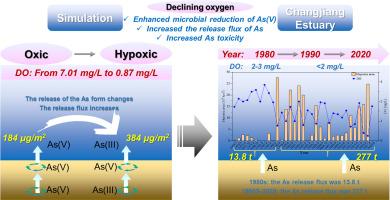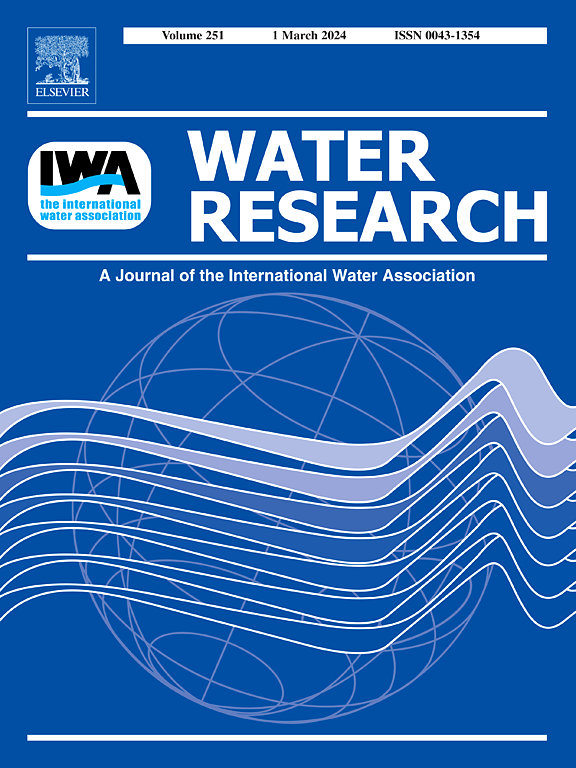Hypoxia exacerbate the marine ecological risk of arsenic: by stimulating its migration and release at the sediment-water interface
IF 11.4
1区 环境科学与生态学
Q1 ENGINEERING, ENVIRONMENTAL
引用次数: 0
Abstract
Hypoxia severally increased the release and bioavailability of sedimentary arsenic (As) in marine systems. However, the specific details regarding As migration and associated risks during exacerbated deoxygenation remain unclear. In this study, simulation experiments were conducted at four different dissolved oxygen (DO) levels to investigate the effects of exacerbated hypoxia on As mobility across the sediment-water interface (SWI). Hypoxia induced a rapid release of both As(V) and As(III), with a higher release rate for As(III) compared to As(V) across all experimental groups. The amount and rate of dissolved total As (dTAs) released across the SWI was proportional to the reduction in DO over the incubation time. The labile As in the solid phase was predominantly in the form of As(V) across all experimental groups. However, As(V) and As(III) were be dominant in surface and deep porewaters, respectively, accompanied by a decrease in the solid As in the reducible fraction and a significant increase in the abundance of the As(V)-reducing functional gene arrA with depth in the low DO groups. This suggested that hypoxia enhanced As exchange between surface sediment and overlying water by promoting the reductive dissolution of As(V)-bearing Fe/Mn oxides and exacerbated the partitioning of As from deep sediments to porewater by preferentially driving As(V) reduction. Although the diffusion of As to the overlying water was paralleled by dissolved Fe, there was a decoupling between them due to the involvement of As(V)-reducing bacteria and desorption of Mn oxides. After the completion of the hypoxia incubation, dTAs concentrations in the overlying water exceeded levels in clean coastal waters by ∼6-fold, reaching reported concentrations that affect the detoxification mechanisms of microalgae. Based on the estimation, about 34 t of As was released into the overlying water during the hypoxic period in the Changjiang Estuary, accounting for up to 17.3% of the surface sediment As capacity.

缺氧加剧砷的海洋生态风险:刺激砷在沉积物-水界面的迁移和释放
缺氧严重增加了海洋系统中沉积砷(As)的释放和生物利用率。然而,有关加剧脱氧过程中砷迁移和相关风险的具体细节仍不清楚。本研究在四种不同的溶解氧(DO)水平下进行了模拟实验,以研究加剧缺氧对砷在沉积物-水界面(SWI)上迁移的影响。缺氧导致 As(V) 和 As(III) 迅速释放,在所有实验组中,As(III) 的释放率高于 As(V)。整个 SWI 中溶解的总 As(dTAs)的释放量和释放速率与培养时间内溶解氧的减少成正比。在所有实验组中,固相中的易溶解砷主要以 As(V) 的形式存在。然而,As(V) 和 As(III) 分别在表层和深层孔隙水中占主导地位,同时在低溶解氧组中,可还原组分中的固相 As 减少,As(V) 还原功能基因 arrA 的丰度随深度的增加而显著增加。这表明缺氧通过促进含As(V)的铁/锰氧化物的还原溶解,增强了表层沉积物与上覆水之间的As交换,并通过优先驱动As(V)还原,加剧了As从深层沉积物向孔隙水的分区。虽然砷向上层水的扩散与溶解铁的扩散同步,但由于砷(Ⅴ)还原菌的参与和锰氧化物的解吸,两者之间出现了脱钩现象。缺氧培养结束后,上覆水中的 dTAs 浓度超过了沿海清洁水体的 6 倍,达到了影响微藻解毒机制的报告浓度。根据估算,长江口缺氧期间约有 34 吨 As 被释放到上覆水中,占表层沉积物 As 容量的 17.3%。
本文章由计算机程序翻译,如有差异,请以英文原文为准。
求助全文
约1分钟内获得全文
求助全文
来源期刊

Water Research
环境科学-工程:环境
CiteScore
20.80
自引率
9.40%
发文量
1307
审稿时长
38 days
期刊介绍:
Water Research, along with its open access companion journal Water Research X, serves as a platform for publishing original research papers covering various aspects of the science and technology related to the anthropogenic water cycle, water quality, and its management worldwide. The audience targeted by the journal comprises biologists, chemical engineers, chemists, civil engineers, environmental engineers, limnologists, and microbiologists. The scope of the journal include:
•Treatment processes for water and wastewaters (municipal, agricultural, industrial, and on-site treatment), including resource recovery and residuals management;
•Urban hydrology including sewer systems, stormwater management, and green infrastructure;
•Drinking water treatment and distribution;
•Potable and non-potable water reuse;
•Sanitation, public health, and risk assessment;
•Anaerobic digestion, solid and hazardous waste management, including source characterization and the effects and control of leachates and gaseous emissions;
•Contaminants (chemical, microbial, anthropogenic particles such as nanoparticles or microplastics) and related water quality sensing, monitoring, fate, and assessment;
•Anthropogenic impacts on inland, tidal, coastal and urban waters, focusing on surface and ground waters, and point and non-point sources of pollution;
•Environmental restoration, linked to surface water, groundwater and groundwater remediation;
•Analysis of the interfaces between sediments and water, and between water and atmosphere, focusing specifically on anthropogenic impacts;
•Mathematical modelling, systems analysis, machine learning, and beneficial use of big data related to the anthropogenic water cycle;
•Socio-economic, policy, and regulations studies.
 求助内容:
求助内容: 应助结果提醒方式:
应助结果提醒方式:


